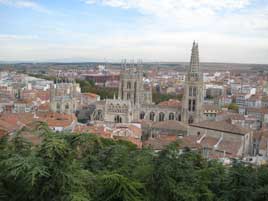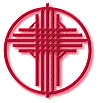The Banstead 5 Pilgrimage 2007
Santiago de Compostela, 21-28 October 2007

Our pilgrimage started on Saturday evening when we assembled at All Saints’ Church for prayer and for Revd Pat to bless our pilgrims’ badges.
On to Burgos on Sunday and, three hotels later, the pilgrims arrived at Santiago de Compostela. En route we visited five cathedrals, at Burgos, Leon, Astorga, Lugo and Santiago, three churches at Fromista, Noia and Muoros, and two monasteries at Burgos and Carrion de los Condes. Although we derived a lot of pleasure and knowledge from all the buildings it was at the cathedrals in Burgos, Leon and Santiago that we enjoyed guided tours.
Burgos has Spain’s third largest cathedral, founded in 1221. The style is Gothic; it has many chapels and tombs. Each chapel altarpiece seemed to be more magnificent that the previous and the chapel of Santa Ana where we celebrated the Eucharist was no exception. Of the tombs the most notable was that of El Cid.
En route to Leon, which was to be our next stay, we visited the Romanesque church of St Martin at Fromista. Compared with the cathedrals it was a simple but interesting building and well worth the detour. We arrived at Leon on a wet afternoon and visited the cathedral the following morning. Here was another grandiose 13th-century building, not as large as Burgos but possessing a magnificent Gothic-style frontage. The outstanding features are the stained glass windows, 180 in all, dating from the 13th to the 20th centuries.
Astorga was our first stop the next day. It has a fine 15th-century cathedral but the main interest was the Bishop’s palace, modestly designed by Antoni Gaudi and bearing little resemblance to some of his works in Barcelona. The diocese did not like the finished article so no Bishop has lived there and it is now a museum. The walled city of Lugo was also visited. An interesting town but as it was now siesta time we were lucky to find an ice-cream shop open.

And so to our goal - Santiago de Compostela. Our first sight of the Cathedral was late evening and bathed in the glow of a full moon which had the effect of making the Cathedral look bigger and better than any photograph. It was the pot of gold at the end of the rainbow. The next day we visited some towns in the vicinity, ending at Cape Finisterre of weather forecast fame. Here we celebrated open-air Eucharist in rather breezy conditions.

The penultimate day gave us a guided tour of buildings adjacent to the Cathedral and then we entered the Cathedral. First impressions were that there was not sufficient light to see in detail but that soon dissipated and we were able to look in wonder. We were told there would be a special service for pilgrims at noon when the botafumeiro, an enormous incense burner, would be swung. Just above the high altar and near the conclusion of the service this large silver-plated vessel is lowered from the roof and, after filling and lighting, it is swung from side to side by seven trained men. In a short time the burner is swinging through almost a 180° arc, then allowed to slow and eventually secured by a priest. Very spectacular and we were privileged to be part of it.
At 7.30 am on our last day we returned to the Cathedral for a private Eucharist service in one of the many chapels. It was a fitting finale to a memorable week.
M. & D. N.

